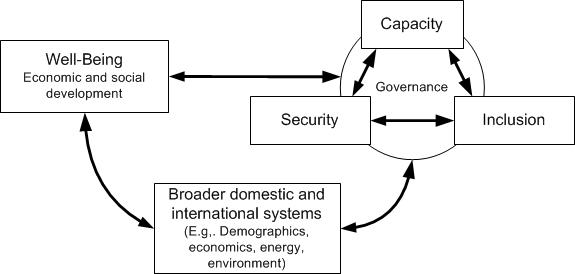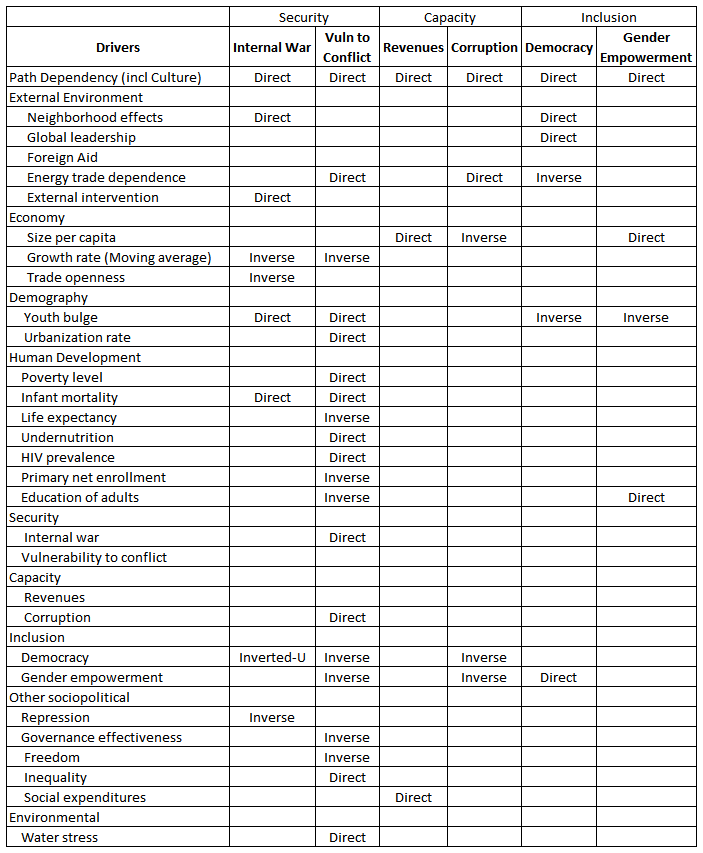Governance
The most recent and complete governance model documentation is available on Pardee's website. Although the text in this interactive system is, for some IFs models, often significantly out of date, you may still find the basic description useful to you.
Governance is the two-way interaction between government and the broader socio-political or, even more broadly, socio-cultural system. Although our documentation and the IFs model itself focuses primarily on three dimensions of that governance interaction, we will need also to direct some attention specifically to that broader socio-cultural system and how it might change over time.
Overview
The conceptual foundation for the representation of governance in IFs owes much to an analysis of the evolution of governance in countries around the world over several centuries. That analysis (see Chapter 1 of the Strengthening Governance Globally volume by Hughes et al. 2014) identified three dimensions of governance: security, capacity, and inclusion. It traced them over time and noted their largely sequential unfolding for currently developed countries and their currently simultaneous progression in many lower-income countries.
The three dimensions interact closely and bi-directionally with each other. They also interact bi-directionally with broader human development systems. The level of well-being, often captured quantitatively by GDP per capita or the more inclusive human development index, may be especially important, but is hardly alone in helping drive forward advance in governance; for instance, the age structures of populations and economic structures also interact with governance patterns both indirectly through well-being and directly.
The conceptualization of governance further divides each of the three primary dimensions into two sub-dimensions partly based on the desire to quantify them historically and to facilitate forecasting. For security those are the probability of intrastate conflict and the general level of country performance and risk. The two sub-dimensions of capacity are the ability to raise revenue and the effective use of it and the other tools of government—that is, the competence or quality of governance. We use corruption (that is, control of it) as a proxy for such competence. The first sub-dimension of inclusion is the level of formal democratization, typically assessed in terms of competitive elections. More broadly democratization involves inclusion of population groupings across lines such as ethnicity, religion, sex, and age; we use gender equity as a proxy for the second dimension.
See Hughes et al. (2014), especially Chapter 4, for more background on the development of the governance representations of IFs than this documentation provides. See also Hughes (2002) for earlier and/or complementary work in IFs on socio-political representations (domestic and international); for example, here we do not discuss the formulations for power, interstate threat, and conflict, but that is available in documentation on the International Political model of the IFs system. Finally, we not provide here the important information about the forward linkages of governance to other elements of IFs, including to the production function of the economic model and to the broader financial flows of the social accounting matrix representation. See documentation on the economic model for that information.
Structure and Agent System: Governance
System/Subsystem
|
Governance
|
Organizing Structure
|
Three dimensions with two sub-dimensions each; highly interactive, bi-directional relationships among dimensions and with socio-economic development, demographics, and economics
|
Stocks
|
Socio-economic development levels (e.g. level of education, gender relationships, size of the economy); past patterns of governance; also cultural patterns are a stock
|
Flows
|
Government spending on human capital, infrastructure, development generally; accretion of changes in governance over time
|
Key Aggregate Relationships (illustrative, not comprehensive)
|
Probability of intrastate conflict is a function of past conflict, neighborhood effects, economic growth rate (inverse), trade openness (inverse), youth bulge, infant mortality, democracy (inverted-U), state repression (inverse), and external intervention. Vulnerability to intrastate conflict is a function of past intrastate conflict, energy trade dependence (as a proxy for broader natural resource dependence), economic growth rate (inverse), youth bulge, urbanization rate, poverty level, infant mortality, life expectancy (inverse) undernutrition, HIV prevalence, primary net enrollment (inverse), adult education levels (inverse), corruption, democracy (inverse), gender empowerment (inverse), governance effectiveness (inverse), freedom (inverse), inequality, and water stress Government revenues are a function of past revenue as percentage of GDP, GDP per capita, and social expenditures (that is, inversely to fiscal balance). Corruption is a function of past corruption level, GDP per capita (inverse), energy trade dependence, democracy (inverse), gender empowerment (inverse), and probability of intrastate conflict. Democracy is a function of past democracy level, youth bulge (inverse), and gender empowerment. Gender empowerment is a function of past gender empowerment level, GDP per capita, youth bulge (inverse), and primary net enrollment.
|
Key Agent-Class Behavior Relationships (illustrative, not comprehensive)
|
Social sub-group relationships, especially historical conflict patterns and gender relationships; government revenue and expenditure
|
Dominant Relations: Governance
The drivers of change on each dimension and sub-dimension of governance range widely. A quick summary (see also the table below) is that:
- Probability of intrastate conflict is a function of past conflict, neighborhood effects, economic growth rate (inverse), trade openness (inverse), youth bulge, infant mortality, democracy (inverted-U), state repression (inverse), and external intervention (inverse).
- Vulnerability to intrastate conflict is a function of energy trade dependence, economic growth rate (inverse), urbanization rate, poverty level, infant mortality, undernutrition, HIV prevalence, primary net enrollment (inverse), intrastate conflict probability, corruption, democracy (inverse), governance effectiveness (inverse), freedom (inverse), and water stress.
- Government revenues are a function of past revenue as percentage of GDP, GDP per capita, and fiscal balance (inverse).
- Corruption is a function of past corruption level, GDP per capita (inverse), energy trade dependence, democracy (inverse), gender empowerment (inverse), and probability of intrastate conflict.
- Democracy is a function of past democracy level, economic growth rate (inverse), youth bulge (inverse), and gender empowerment.
- Gender empowerment is a function of past gender empowerment level, GDP per capita, youth bulge (inverse), and primary net enrollment.
There are some general insights with respect to elaboration of the formulations (equations and algorithms) that drive change on each dimension and sub-dimension of governance:
- In almost each case there are path dependencies that supplement the basic relationships—social change has considerable inertia.
- The driving and driven variables clearly constitute a complex syndrome of mutually interdependent developmental interactions, not a simple causal sequence.
- There is a tendency for the dimensions of governance traditionally developing later to feed back to earlier ones, notably for inclusion to affect capacity via reduced corruption and also for inclusion and capacity to reduce the probability of internal conflict.
- Behaviorally, the bi-directional structures suggest the possibility that reinforcing processes may accelerate as governance strengthens, setting up a kind of tipping from one equilibrium to another; vicious cycles of deterioration would also be possible.
For detailed discussion of the model's causal dynamics, see the discussions of flow charts (block diagrams) and equations. <header><hgroup>
Governance Flow Charts
</hgroup></header>
Overview
We can show and briefly describe a block diagram for each of the three dimensions of governance and the two sub-dimensions of those: security (probability of intrastate or internal war and risk of conflict); capacity (ability to mobilize revenues and the effectiveness of their use); inclusiveness (formal democracy and broader inclusiveness, using gender empowerment as a proxy).
Please click on the links below to access these topics. <header><hgroup>
Security
</hgroup></header>
Internal War
Internal or intrastate war (SFINTLWAR) is heavily determined by a moving average of a society's past experience with such conflict (SFINTLWARMA) in what is a positive feedback system. The probability of such conflict will, however, typically converge to that determined by more basic underlying drivers, and the user can control the speed of such convergence by specifying the years to convergence (sfconv ).

